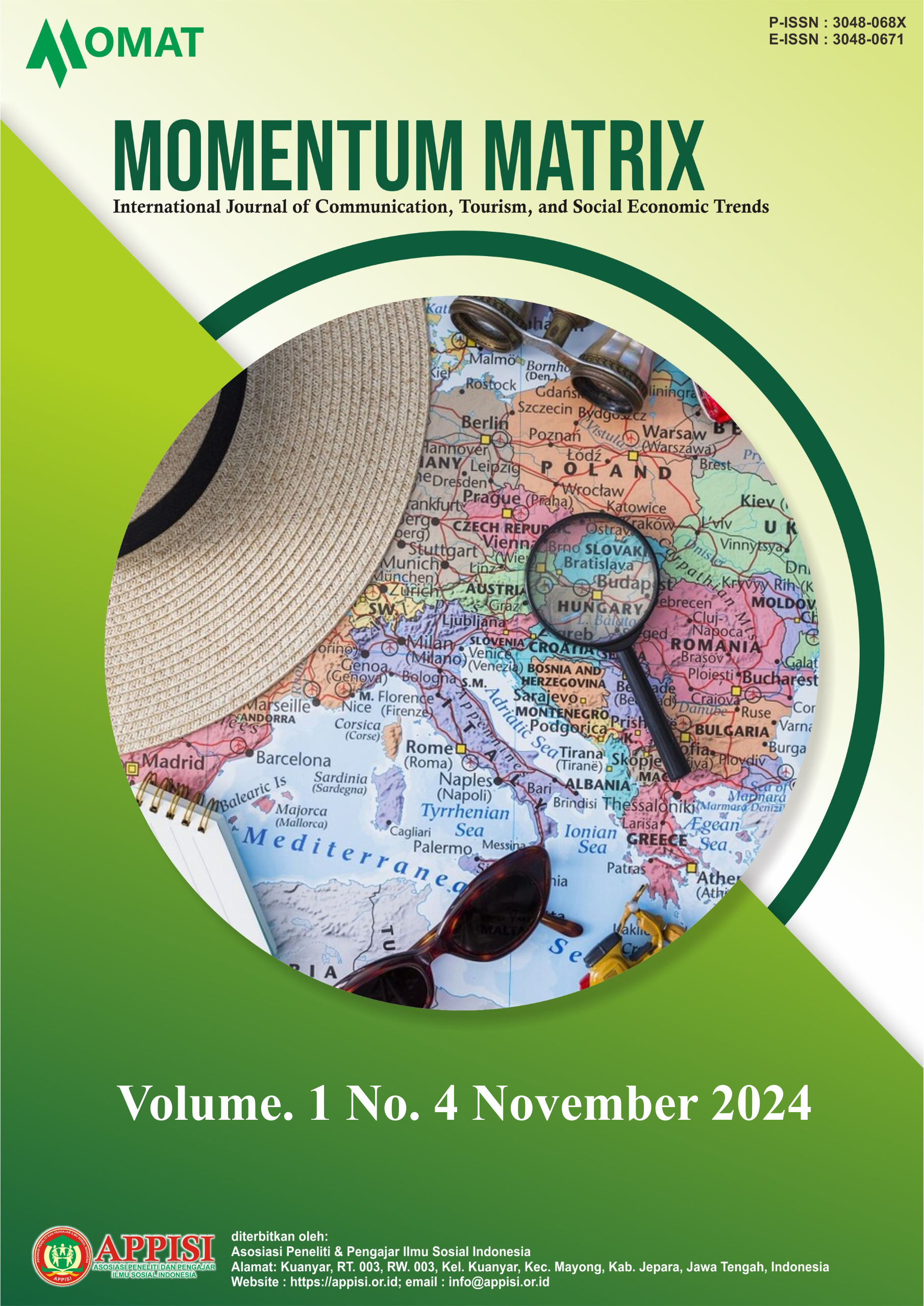The Semiotic Analysis of Artistic Symbols and Da'wah Messages in the Jaranan Tril Turonggo Mudo Dance of Blitar, East Java
DOI:
https://doi.org/10.62951/momat.v1i4.64Keywords:
Semiotics, Art symbols, Da”wah messages, Jaranan Tril danceAbstract
The aim of this research is to conduct a semiotic analysis of the artistic symbols and da'wah messages in the Jaranan Tril Turonggo Mudo Dance from Blitar, East Java. This study employs a qualitative research approach, with the subjects including dancers, cultural figures, and members of the community who appreciate the Jaranan Tril performance and possess in-depth knowledge about it. These subjects consist of one spiritual leader, one trainer, two dancers, and one resident of Gogodeso Village, Kanigoro District, Blitar Regency. Informants were selected using purposive sampling. Data collection techniques included interviews, observation, documentation, and literature review. The data were analyzed qualitatively using a descriptive method, with the analysis results presented in narrative form to explain the phenomena examined in this research. The findings reveal that the Jaranan Tril Dance performance is divided into three acts: the opening act (bukak kalangan), the main session, and the final session (kesurupan) and closure. Each session carries symbolic meaning. The opening act is intended to seek protection from the Creator and symbolizes the start of the Jaranan Tril Dance performance. This session includes an introductory sequence of five movement types that express the prowess of warriors or knights as heroes, embodying boldness and courage. The main session features three movement types symbolizing warfare. The kesurupan (trance) and closing session hold symbolic meaning related to beliefs in the existence of other, unseen life forms, or invisible spirits. During the kesurupan session, the possessed dancers (caplokan) perform unconscious actions and feats. This study recommends that future researchers interested in similar topics explore other types of Jaranan dances found across Java, which may offer new and deeper perspectives on the cultural and symbolic richness of Jaranan dance in this region.
Downloads
References
V. A. Heswati, “Makna Simbolik Tari Reyog Kendhang di Desa Gendingan Kecamatan Kedungwaru Kabupaten Tulungagung Kajian Folklor,” Nuevos Sist. Comun. e Inf., pp. 2013–2015, 2021.
M. R. Aini, “Kesenian Jaranan KPK (Kridho Panji Kusumo) Kota Blitar Sebagai Simbol Makna Kultural (Sebuah Studi Linguistik Antropologi),” J. Frasa J. Keilmuan Bahasa, Sastra dan Pengajarannya, vol. 3, no. 1, pp. 1–11, 2022.
E. Riady, “Jaranan Tril di Blitar Ditetapkan Sebagai Warisan Budaya Tak Benda. Surabaya, Jawa Timur , Indonesia .,” 2022.
N. Adlina, “https://warisanbudaya.kemdikbud.go.id/?newdetail&detailTetap=2648. Retrieved from www.kemendikbud.go.id: https://warisanbudaya.kemdikbud.go.id/?newdetail&detailTetap=2648,” 2021.
I. S. W. Wibowo, Semiotika Komunikasi. Jakarta: Mitra Wacana Media, 2011.
Ratna Wulandari and Aswarini Sentana, “Analisis Semiotika Dalam Lirik Lagu Wijayakusuma Karya Ardhito Pramono,” J. Sos. Hum. dan Pendidik., vol. 2, no. 2, pp. 28–34, 2023, doi: 10.56127/jushpen.v2i2.819.
J. W. Creswell, Research Design: qualitative, quantitative, and mixed methods approaches. California: Sage, 2018.
Sumaryono, Antropologi Tari Dalam Perspektif Indonesia. Yogyakarta: Media Kreativa, 20174.
A. Sobur, Semiotika Komunikasi. Bandung: Remaja Rosdakarya, 2006.
B. H. Hoed, Semiotik dan Dinamika Sosial Budaya. Depok: Komunitas Bambu., 2014.
A. Ferdian, Rusman, and Asrori, “Philosophy, Education, and Values Religious in Culture Pegon Jaranan Dance,” J. Pendidik. Islam, vol. 5, no. 2, pp. 852–863, 2022.
A. Fitriyah, I. Baskoro, R. A. Firnanda, and A. Hamdan, “Jaranan Mataraman Art: Representation of History and Moral Values in Dusun Sanan, Blitar,” ISLLAC J. Intensive Stud. Lang. Lit. Art, Cult., vol. 8, no. 1, p. 187, 2024, doi: 10.17977/um006v8i12024p187-200.
Y. T. Laksono, “Communication and ritual on jaranan pogogan: The semiotics of performing arts,” J. Stud. Komun. (Indonesian J. Commun. Stud., vol. 5, no. 2, pp. 493–508, 2021, doi: 10.25139/jsk.v5i2.3061.
S. Darihastining, “Jaranan Mataram ART: Representation of History And Moral Values in Dusun Sanan, Blitar,” ISLLAC J. Intensive Stud. Lang. Lit. Art, Cult. Vol., vol. 8, no. 1, pp. 187–200, 2024.
Downloads
Published
How to Cite
Issue
Section
License
Copyright (c) 2024 Momentum Matrix: International Journal of Communication, Tourism, and Social Economic Trends

This work is licensed under a Creative Commons Attribution-ShareAlike 4.0 International License.





